Fun at SaltCon 2016 continued – Day 2
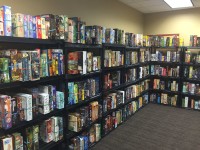
After a full Day 1 at SaltCon 2016 into the wee hours, I headed to my hotel room for a few hours of sleep before diving back into many more tabletop games on Day 2.
Of course, in addition to playing games, I took more time on Friday to visit with the exhibitors in the game hall and talk to publishers and game designers. I also perused the Game Swap area every now and then for a hidden game gem.
After the main game hall opened that morning, I once again found a couple friends and we headed for the Hot Games area.
Now on to mini game reviews of the 11 games I played on Day 2!
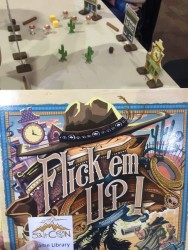
If you’d like to jump to a particular game, click on the name in this list:
- Flick ‘Em Up!
- The Voyages of Marco Polo
- Power Grid: Australia
- Blood Rage
- Isle of Skye
- Longhorn
- Medieval Academy
- Forbidden Desert
- Metropolys
- Chicago Express
- Gold West
8. Flick ‘Em Up!
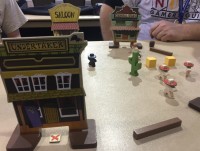
Flick ’em Up! is a fun dexterity game set in the Wild West. Players split into teams of Lawmen and Outlaws and battle it out on the streets of town by flicking discs.
There’s no doubt Flick ’em Up! is a beauty to behold. It totally creates the ambiance of a western town complete with buildings, cactus, and even hay bales. It’s hard to pass by the game table without wanting to play.
Flick ’em Up! was also I game I had already planned on playing at SaltCon. I had heard a lot about it being a fun family game. So when I saw it on the Hot Games list, I knew I’d have my chance.
Doug, Alex, his son Craig, another gal, and I split up into teams and the battle was on.
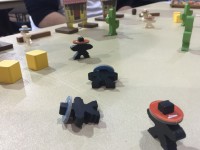
In Flick ’em Up! each team has 5 characters and each character can take two actions — usually a Move (brown disc) and Shoot (grey piece). Starting with the character in the #1 spot play alternates between teams and in numerical order of the characters. With 10 little wooden dudes in town, the easy way to know which have already taken a turn is by flipping over their hat after they’ve done their action.
The game has a bunch of different scenarios and we played the first scenario since the game town was already set up that way. But flipping through the rulebook, I saw that there are a bunch of different scenarios that look really fun. And each scenario comes with unique objectives as well – liked having the outlaws rob the town bank and such.
Or you can obviously create your own scenario and objectives.
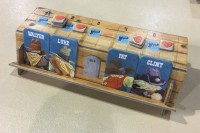
In our game the simple goal was to eliminate 3 characters of the other team. Each character has 3 heart tokens and each time they’re hit, they lose a token. While our game was a close one, I’m sad to say that the outlaws prevailed that morning (obviously I was on the lawmen side).
Moving into closer range before taking a shot can make it more accurate, but it also puts your character into the dangerous situation of being hit as well. Of course, that’s also part of the fun.
But what’s really puts a smile on my face is taking a long shot and scoring a hit.
Playing Flick ‘em Up! was a great way to start the day.
9. The Voyages of Marco Polo
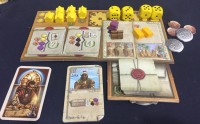
Doug, Alex, Craig, and I then moved over to another Hot Games table and learned how to play The Voyages of Marco Polo.
While Flick ‘em Up! didn’t need much explanation, The Voyages of Marco Polo on the other hand took a while to go through the rules. Thank heaven for Claudine! She was one of the volunteers in the Hot Games area that morning teaching game rules. And she did a great job teaching us how to play.
One funny thing is that as she explained the special power that I drew at the start of the game, she had an “a-ha” moment. She quickly noted that the day before another player in their game had that power and had played it wrong. As she explained it to us, she realized the error in the previous game and quickly realized why that player had totally run away with the game. Claudine couldn’t help bringing others over to our table while we played to show them my power and how it was interpreted wrong in the other game. All of them had that “no wonder” look on their face and looked quite relieved to now know the correct ability.
Anyway, in The Voyages of Marco Polo, players recreate a journey that 17-year old Marco Polo and his father and brother took in 1271-1275 along the “Silk Road” to the court of Kublai Khan.
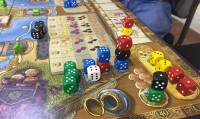
Players have 5 colored dice that they use to perform actions based on where they place their dice. The first comparative game that popped into head for me is one of our favorites – Alien Frontiers. Of course, I soon learned that even though we’re rolling dice and placing them in different areas of the board for actions, the game play was quite different.
The first difference that I really liked is that players each take turns placing their dice in one area. In Alien Frontiers, a player rolls and then places all of their dice in various areas. Thus, it can take a while before it’s your turn again. But in The Voyages of Marco Polo, I would place a die or dice in one area for an action, then the next player would do the same with their dice. If I still had dice left when it came back around to me, I could take another action. It’s a great way to keep everyone engaged with less downtime between each turn. That way you also get more turns in during the game even though there are only 5 rounds to the game.
Of course, having only 5 rounds to the game tells you right from the start that you’ll have to be efficient in your actions. And with so many options of what to do, there’s plenty to contemplate. As with many such games of choices like this, you’ll quickly find that you can’t do everything you’d like. So you’ll have to choose a general strategy to pursue and stick with it. And a lot of times that may be dictated by what special power you have.
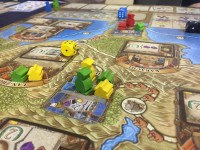
For example, in our game I was able to get one resource each time other players took a certain action (resources are camels, pepper, silk, and gold). Knowing that I’d get a bit more resources than others, I chose to try to compete as many orders as I could. Whereas another player was aiming to get to as many cities as he could to gain first mover advantage in each of those locations. So he was traveling a lot.
Another cool difference in The Voyages of Marco Polo vs. Alien Frontiers is that other people’s dice doesn’t block out spots in most locations. There are some spots where that’s the case. But in many spots players can stack their dice on other dice for a cost. It makes for some additional interesting choices.
After the 5 rounds are over, players earn additional victory points for arriving in Beijing, fulfilling the most orders, and having reached the cities on secret city cards that each player gets at the start of the game. Add up all the points and see who wins.
We had a pretty close game so it wasn’t clear who was going to win until the final tally of extra points. For such a thought-provoking game, I was relieved to have edged out a win in the end. But the outcome didn’t really impact the enjoyment of the game. It was fun figuring out different options to gain a bit of an advantage here and there along the way.
Buy a copy of The Voyages of Marco Polo.
10. Power Grid: Australia
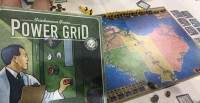
During a bit of a breather after our 2nd game, Adam found me to tell me that they were setting up a game of Power Grid. And if you’ve seen any of my favorite games lists, you’ll know that Power Grid is right at the top. I love Power Grid!
And a chance to play Power Grid with a different group of players sounded like an opportunity too good to pass up.
When I got to the table, I was excited to see a map that I hadn’t played before – Australia.
Each Power Grid map comes with its unique set of rules and conditions that put a bit of a twist on each game. And it’s just enough of a twist to make the choices continually interesting.
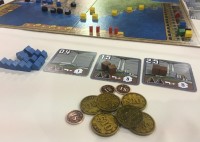
Besides the stark open spaces between major city areas in Australia, a big change for this map was the way uranium was handled. Instead of being a resource to buy and power up power plants, it designated mines. So instead of burning that as fuel, those power plant cards would generate income based on where the uranium tokens were on the market track.
That different added a cool twist that we all had to figure out how to value and determine when/how/if to leverage it during the game.
We played a 5 player game and as usual, it was a tight game clear through to the end. Doug, Adam, and I played with a couple players that we hadn’t met before and had a great time. We also cool game coins that Adam has instead of using the Power Grid paper money. And it sure made me want to pick up some cool game coins as well. They were very fun to play with.
Buy a copy of Power Grid and Power Grid: Australia.
After playing a familiar game and taking a break for a late lunch (3pm-ish), I met up with Doug again to hit a couple more Hot Games, starting with…
11. Blood Rage
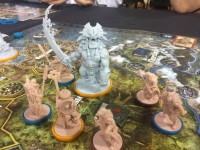
I’ve heard a lot of hype about Blood Rage over the last few months, so when I saw it on the Hot Games list, it was another “must play” for me. So I was excited when Doug and I found an opening at the Blood Rage table and met two other gents for a friendly game of deadly Viking battles!
In Blood Rage, each player controls their own Viking clan’s warriors, leader, and ship. Ragnarök has come, and it’s the end of the world! It’s the Vikings’ last chance to go down in a blaze of glory and secure their place in Valhalla at Odin’s side.
For a Viking there are many pathways to glory. You can invade and pillage the land for its rewards, crush your opponents in epic battles, fulfill quests, increase your clan’s stats, or even die gloriously either in battle or from Ragnarök, the ultimate inescapable doom.
There are only 3 ages in the game, so players have to be judicious on what they pursue.
At the beginning of each age/round, players draft cards that will grant the actions to be taken. Some include extra strength in battles, some grant upgrades to the clan, some provide quests to pursue, and some generate aid from legendary creatures from Norse mythology.
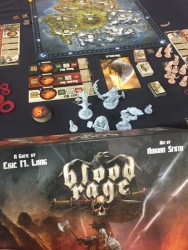
And this is where I’ll throw in that the creature miniatures are stunning. There’s no doubt I want one of those creatures on my side!
Most of the cards are aligned with one of the Norse gods, hinting at the kind of strategy they support. For example, Thor gives more glory for victory in battle, Heimdall grants foresight and surprises, Tyr strengthens players in battle, while the trickster Loki actually rewards losing battles, or punishes the winner.
Battles are decided not only by the strength of the figures involved, but also by cards played in secret. However, winning battles isn’t always the best way to go. With the right card, you can get even more rewards by being crushed.
While I enjoyed playing Blood Rage, it didn’t strike a strong cord with me. There’s no doubt the miniatures look fantastic and menacing. The card drafting at the start of each round to plan strategies is great. And the choices of which areas to invade and maneuver to were very cool. I also know that familiarity with which cards could become available in each age would be helpful to doing better in the game. However, in the end, I didn’t feel drawn to wanting to get to that stage. I wasn’t aching to play it again to discover all those cool possibilities.
That being said, if I was invited to play Blood Rage again, I sure wouldn’t turn it down. I just won’t be the one suggesting it or seeking it out.
12. Isle of Skye: From Chieftain to King
On the flip side of Blood Rage, Isle of Skye: From Chieftain to King is definitely a game I want to play again!
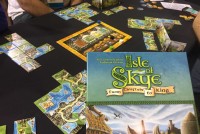
I guess I better start out by sharing my bias towards tile-laying games. I love games that involved laying out tiles and watching the playing area take shape. Carcassonne is still a game I love because of how cool the table looks when the game ends. I feel invested in the way the countryside takes shape and feel like I’m helping shape a new area of the world.
So when I first saw Isle of Skye and discovered that in the game players each create their own unique island, I figured it would be one I’d like.
And I’m happy to report that it lived up to my hopes.
I won’t dive into the preamble of theme behind Isle of Skye because I didn’t think it mattered much in the game play. In essence, each player builds their own island using tiles they purchase and scores points based on how they do.
There were a number of things I really liked about the game that leave me wanting to play again.
The first is that the scoring options change every game and from round to round.
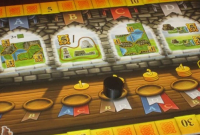
The game includes 16 scoring tiles that indicate possible ways to score. Each game, only 4 of those tiles will be used. In addition to that variety, each tile will score during different rounds of the game. Each scoring manner will be in effect during 3 rounds of the game, but which rounds they are will vary. For example one method for scoring will occur in the first, second, and forth round whereas another will be the second, forth, and fifth rounds.
The variety in what items will score reminds me a lot of another game I love to play – Kingdom Builder. I love the puzzle-like nature of getting a random set of ways to score points and figuring out the best way to accomplish those objectives each game. It keeps the game fresh while still using mechanics that I’m already familiar with.
Paying attention to when different tiles will score is a key element of the game, and I love the challenge of trying to figure out how to maximize those opportunities.
The second element that I really liked is how the tiles are gained. Each player draws 3 tiles from the bag each round. They place those in front of their player screens and then secretly indicate which one to toss out and what the price of the other two will be. Then everyone moves their player screen and reveals their choices. The tile each player chose to eliminate is placed back in the bag and then in turn order players can pay the cost for one tile from an opponent (or choose not to). Once everyone has had a chance to purchase a tile, any tiles not bought by an opponent are then purchased by the player themselves.
It’s a great mechanic that keeps players figuring out how to price their tiles. They can see which tiles might be enticing to the other players based on how those islands are shaping up. So they could price those tiles high in order to gain the money from those players purchasing those tiles from them. However, if they’re priced too high, other players won’t purchase the tiles and the player who set the high price will have to pay that amount of money to keep the tiles for their own island.
I really like that unique aspect of the game. Very cool.
After all players have gained tiles, they then place them on their growing island and the round is scored.
If I recall correctly Doug and I ended the game tied for first place. However, I don’t remember what is used as the tiebreaker and it doesn’t really matter to me. I really enjoyed the game and would love to play it with my family as well. I think they’d enjoy it too.
(I wish I would have taken more pictures during the game. But I guess I was too caught up in playing to think about snapping a shot.)
Buy a copy of Isle of Skye: From Chieftain to King.
13. Longhorn
By this point in the day I was ready for bit of a mental break. Like different course in a great meal, it’s good to include a variety of items.
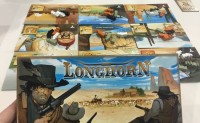
Thus, Doug and I sat down to play a couple lighter and less mentally taxing games.
The first one we played was a game I had taken with me to SaltCon – Longhorn.
We reviewed Longhorn last year and find it a fun and quick 2-player game that has a bit of variety and interesting choices. I also thought it would be a game that no many people had played and would be a good one to introduce to the friends I’d meet up with again at SaltCon.
It turns out that Doug had gotten a copy of Longhorn for Christmas but had yet to play it. So he was excited for a chance to give it a go.
Because it’s a quick game, we played a couple games of it back-to-back and Doug was all set to play it with his family after the con.
If you’d like to read more about Longhorn, check out our full game review.
14. Medieval Academy
The next game Doug and I played was one that he knew how to play and I wanted to learn — Medieval Academy.
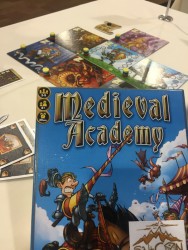
Medieval Academy was another game I had on my “want to play” list going into SaltCon so I was very glad they had a copy of it in the Game Library.
Though up to 4 people can play Medieval Academy, it also has special rules for a 2-player game. So that’s the way we dove into the game.
In Medieval Academy each player takes the role of a squire who wants to outdo the others in the different training categories to score Chivalry Points. The different training categories are actually individual boards with spaces for players’ colored discs to move around as they play cards in that category.
Players draft the different training cards that will allow them to advance on the tracks. Over the course of 6 rounds, players will compare their progress with the others and either score or lose points based on their positions. And like most games, since you can’t be the best in every area, players have to pick and choose where to focus each round.
At the end of the sixth round, the squire who has the most Chivalry Points wins the game and is knighted by King Arthur.
I definitely enjoyed playing Medieval Academy and see it as a good, light game for families with young kids. Unfortunately, I don’t think it would entice our teenagers very much. So while it may have been a good fit for our family a few years ago, we’ll pass on it at this stage.
But I’m very glad I finally got to play it (thanks Doug!) and would recommend it for families with younger kids than us (suggest 7-11 as the optimal age range).
Buy a copy of Medieval Academy.
15. Forbidden Desert
After getting a quick bite to eat for dinner, I saw a familiar face from our Guys Game Night I hold at my house each month. Jason lives in our same city and joined in our game group starting last Fall. He had come with 2 brothers and they had snagged some games from the game library to play together.
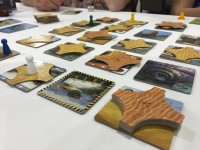
When I noticed the first game they were setting up was Forbidden Desert, I asked if I could join them and they graciously consented.
Forbidden Desert is a fun family cooperative game where everyone works together to find parts to their plane that crashed in the desert so they can rebuild it and escape.
I really enjoy the game because the location tiles keep shifting around due to the wind and sand storms. Since the hidden parts must be discovered amongst the shifting tiles, it’s not just a puzzle to solve. Instead players really have to adjust their choices as the board changes throughout the game.
Even though we thought we were doing fairly well, and we had actually uncovered every part of the plane, we couldn’t make our way back to the exit point before I died of dehydration. Yep, I ran out of water and caused our mission to fail because of it. Bummer.
But even still, it was a lot of fun playing with Jason and his brothers in such a fun setting.
See our video review of Forbidden Desert.
Buy a copy of Forbidden Desert.
16. Metropolys
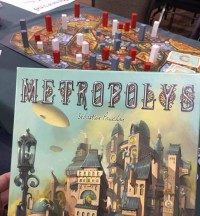
The next game I played was one I had never heard of before – Metropolys. It was another game that Adam had brought along that he was hoping to play. He brought it because it’s one he likes but hasn’t played for a while and didn’t think the game library would have a copy (he was right).
Because it was getting late, we made sure to set up the game in a section of the convention center that would stay open through the night.
Doug was up for another game before heading home, so he joined in and Adam taught us how to play Metropolys.
As you can imagine, the theme of the game is about constructing buildings throughout a city. Actually, players aren’t so much constructing as they are simply placing buildings, but the way it’s done is very unique.
Each player starts with buildings of various sizes that are numbered from 1 to 13. The numbered buildings also serve as bidding markers for the different spaces on the game board.
When it’s a player’s turn to begin, they place one of their buildings (with the bid number up) on a space on the board. The next player can then either pass or raise the bid by placing a higher numbered building into an adjacent space. Once the other players either choose to pass or can’t play a higher numbered building, the winning player makes their final bid a permanent building and turns it over (number-side down) on that location. All the losing buildings/bids are returned to the players and the person who won that round begins the next.
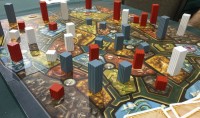
Once a player has placed all of their buildings, the game ends and the most points wins. There’s no “equal turns” in Metropolys. Players must keep an eye on which buildings the other players have left to make optimal maneuvers to ensure they get good placement of their own buildings.
But that’s not all there is to the game. The spaces on the board are divided into regions. The player with the tallest buildings in each region will score points at the end of the game. In addition, at the beginning of the game tokens are randomly placed into the spaces on the board and when a player wins a building spot, they also claim the token. And not all tokens are good. Some will doc you points.
If that weren’t enough, each player also has up to two hidden agendas that they’re secretly trying to achieve and score only at the end of the game.
Thus, strategic placement of bids (as well as the size of the bid) will have a big impact on the outcome. It makes for a very unique game experience that I really enjoyed.
I was intrigued by the game and was hoping to play a second game of it right after. In fact, while writing about it now, I’m anxious to play the game again. And in my book that means it’s a keeper.
Too bad Metropolys is out of print because it makes it very difficult to find a copy. And I have a hunch that Adam won’t be parting with his copy in next year’s SaltCon Math Trade. Looks like I’ll be keeping my eyes open for a good deal on Metropolys somewhere.
17. Chicago Express
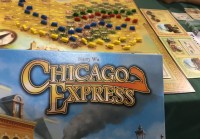
Just as we finished playing Metropolys, a few other friends showed up at a table next to us. Dan was pulling out a game he’d been anxious to play – Chicago Express.
I recall looking into Chicago Express a number of years ago as it looked like an interesting game. So when Dan said that game was hitting the table next, I jumped at the chance to join the group as well (Dan, Matt, Adam, Leo, and I).
Chicago Express is a game without any luck. There’s no dice rolling nor card flipping. It’s straight strategy all the way as players buy shares in railroad companies and expand rail lines toward Chicago.
In Chicago Express 4 railroad companies drive from the East Coast across the growing eastern US to Chicago. Another railroad pops up later in the game near Chicago but most of the game players are dealing with just the original four.
The game is played over 8 rounds and players get to choose one of 3 actions:
- Auction a share of one of the railroad companies
- Expand the rail system of one of the companies
- Develop one of the board hexes
It’s an interesting set of choices in its own right. But a cool element is that each option has a limited number of times it can be used before a dividend phase. Once two of those options have been completely used up, a dividend phase happens – where all players gain income from the railroad companies they have shares of.
Players have total control on when the action options get used up and when dividend phases occur. So positioning for that phase is key.
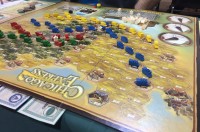
As the game progresses, the price of company shares will increase so that even starting an auction action for company shares will cost more. Of course, players can also bid up the price of those shares forcing other players to either pay more for what they want, or for getting in on the hot company.
Obviously players who own majority shares in a company will want to advance those particular rail lines so that they’ll be more valuable. Since everyone knows who has which shares (and how many) it can also be advantageous to block those advancements or get a piece of the action.
Because of this balance there was plenty of talk throughout the game trying to convince other players what to do. There’s plenty of jockeying for position to get the best payouts.
Since the heart of the game is economic, the player with the most money at the end of the game wins. (Which in this case sure wasn’t me.)
Oh – and while we in the middle of the game, a strange thing happened – all the lights went out!
We were in the large convention hall area with tons of other games going on as well when the lights went out. The first reaction was a huge moan from almost everyone in the room and a handful of “hey, we’re playing in here” shouts.
But of course SaltCon organizers knew this was the central area for playing games through the night so no one really worried about it being handled. We knew it would.
So the next thing you know, people at every game table simply pulled out their phones and flipped on their flashlights.
It was awesome!
It’s not to say that playing games by flashlight is my first choice, but everyone hardly missed a beat. People just kept on playing!
After a few minutes, the lights started to come back on (going through their warm-up and such) and the gaming night continued.
Chicago Express is a game I’d like to play again. I could tell that having some experience with the game was an advantage. So now that I’ve learned a thing or too, I’d give it another go.
Buy a copy of Chicago Express.
18. Gold West
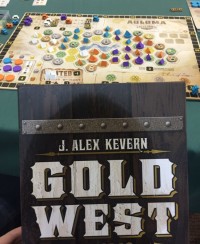
Even though it was now well after midnight, there were plenty of folks still playing games on tables all around. And we just kept on trucking as well.
Now that we’d finished train routes from the East coast to Chicago, it was time to head even further West and Dan introduced Adam, Matt, and I to another game he brought – Gold West.
In Gold West, players compete as prospectors building their mining empires while vying over the precious metals of the frontier. The game is a mix of area control and resource management with a very unique mechanic of how you store and use the resources.
To gain resources, players place one of their tents (that’s what they look like to me) on a spot with a face-up token. The then claim the resources indicated on that token and turn over any
adjacent face-down tokens. That way, players can plan their next moves as they expand and claim more resources.
When players claim resources, they can choose at what level they’ll place them on their player board. The deeper they place the resources, the more points they’ll score immediately. But it will also take longer for them to be able to use those resources to gain something else that grants even more points.
That’s because moving resources up levels uses a Mancala-like system. The player takes all resources on one level of their player board and moves them forward. As they get to the next level, the must drop off one of those resources before continuing. At the next level they do the same, etc. until they are able to move resources completely off their board. Those are the resources that can then be used that turn.
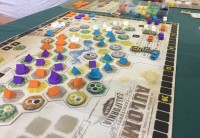
So if resources are placed at the top level, they’ll be able to all be used the very next turn. However, with some planning, players can stock up points and resources by placing at lower levels and then making major moves all at one time as they move large groups of resources off their board.
I decided to focus on gaining Timber and Stone early on and keeping them at a higher level so I could build camps and settlements more quickly in the beginning. Then I’d shift over to the metals (Copper, Silver, Gold) later to grab up points in other ways.
I seemed to be trailing most of the game until I shifted into the metals.
At the beginning of the game, there are some tiles that are randomly placed in a certain area of the central board that also create bonus scoring opportunities for players who claim those spots. And even though I was planning to claim some spots to gain the bonus, I was too late to do so and lost out on most of those spots to the others.
All in all, there are plenty of things to think about and manage during the game. And even though it was about 2:15 am when we finished, my mind was still clicking on all the options throughout the game.
In the end I pulled ahead to win the game in final scoring.
It was a good finish to the day of fun.
A bunch of guys were heading to Denny’s for something to eat, but I pulled out and just went back to the hotel. I was ready for a bit of sleep before another day of gaming on Saturday.
Day 2 Wrap Up
For those keeping score at home, so far the SaltCon-played games I’m most interested in playing again are: Mow Money, Ponzi Scheme, Isle of Skye, and Metropolys.
But I still haven’t told you about Day 3 yet…
Stay tuned for even more mini-reviews as well as info on the Math Trade, Game Swap and other activities that took place at SaltCon.

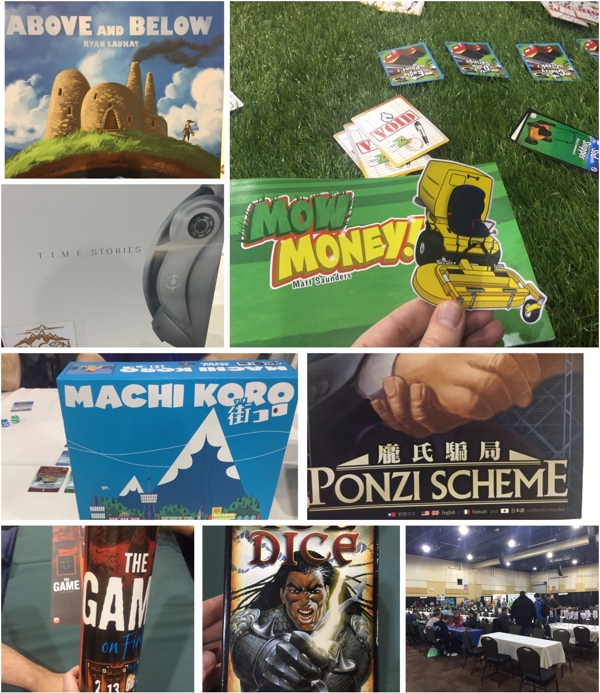
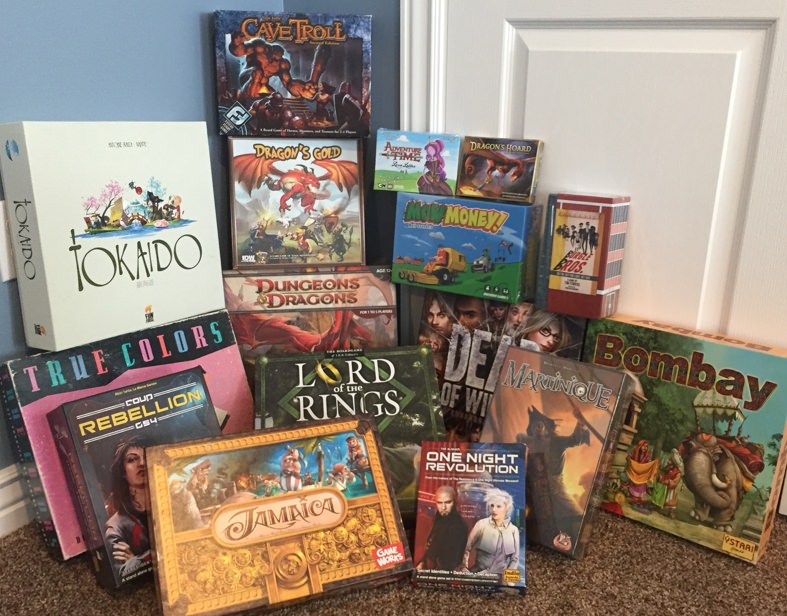
Great recap of another fun day.
Marco Polo was one of the “missed games” of my con. I had planned to play it on Saturday when my family showed up but due to some challenges with one of our sons it didn’t work out as expected. I’ll have to give it a whirl another time.